

7 quick tips for ambient, atmospheric music
Got the basics down? Here's how to make ambient music that offers a little something extra.

Telefon Tel Aviv: Sound design, sine waves, and why ‘wrong’ is often right
We sit down with Josh Eustis to dissect the sounds and techniques behind Dreams Are Not Enough…

Using TRAKTOR in the studio: How the DJ tool is used to make beats
Discovering the creative powers of TRAKTOR for music production with Huerco S., Konx-om-Pax, and exael.

Eomac and Kyoka are Lena Andersson
Learn about the collaborative project between Irish producer Eomac and the Japanese artist Kyoka.

Secrets of electronic interfaces: Modularity
PUSH TURN MOVE and PATCH & TWEAK author Kim Bjørn explores methods for interfacing with music through hardware and software.

Thomas Ragsdale on atmospheric, commercial music
Having scored countless advertisements, the UK producer breaks down his studio tools, workflow and tricks.

Richard Devine: A history of making music
Electronic music pioneer discusses his love for REAKTOR BLOCKS, THRILL, and more.

Robert Dudzic: How to be the best at sound design
Acclaimed sound designer Robert Dudzic divulges his secrets on recording, effects, and how to break into the industry.
Modular synthesis: the ultimate guide
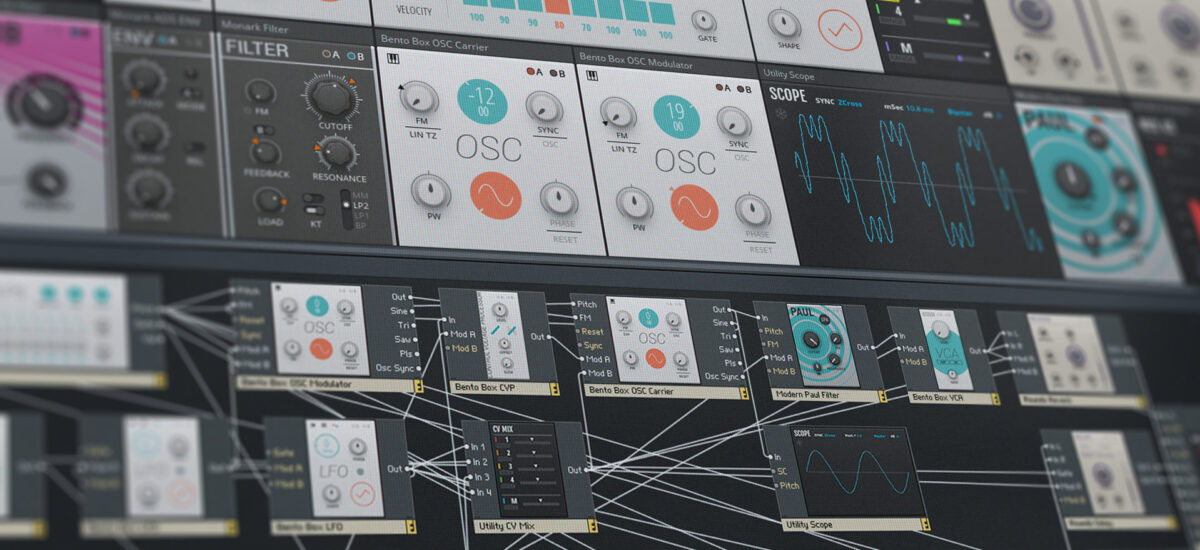
Modular synthesis is one of the most intimidating topics in music production. Those in the know love modular synths, praising them for their versatility and creative potential. But outsiders sometimes struggle to understand what the fuss is about. What is modular synthesis exactly? What makes modular synths special and how do they work? And how can you overcome the steep learning curve to get a solid grip on this unique synthesis method?
This comprehensive guide will answer all of these questions and more. We’ll cover the basic principles of modular synthesis, explain how to build a modular synth, and share inspiring examples of modular synths in action. Read on if you’re keen to learn modular synthesis. Your journey towards the rig of your dreams is about to begin – just take it one module at a time.
Jump to these sections:
What is a modular synthesizer, what does a modular synthesizer do, what is modular synthesis used for, is modular synthesis hard, is modular synthesis expensive, essential components and setup, amplifier (vca), envelope generator (eg), other modulators, filter (vcf), effects modules, output module, patch cables, understanding signal types: audio and cv, building a modular synthesizer, do your research, have a goal, start small, get these basic modules, uses and applications of modular synthesis in music, give familiar genres a fresh twist, generate new patterns and forms, make music tactile, create wild new sounds, expanding your system: from beginner to advanced, explore sound generators, go deep with sequencing, try weird effects.
- Conclusion: Start your modular synth journey
Follow along with this tutorial using Reaktor Blocks.
Get Reaktor Blocks
A modular synthesizer is a synthesizer made out of standalone components, or modules, that work together to create sound. These modules are connected by patch cables in a configuration chosen by the user. By using different modules, and patching them together differently, you can create a huge variety of different sounds using modular synthesis.
In fact, you could argue that all synthesizers consist of distinct modules that perform various functions. But in most synths, the selection and configuration of these modules is fixed by the company that made the synth. Sure, some might give you an aspect of modularity. For example, the popular soft synth Massive X allows you to assign modulators to a wide range of parameters within the synth, and the way you make these connections can change the way the synth behaves. But in conventional synths, there are limits to how far you can customize your sound.
Modular synths offer complete freedom. You can build one out of any of the hundreds of modules on the market – from traditional synth components like oscillators, envelopes, and filters, to powerful sequencers and unique audio effects. And these modules can be patched together in virtually any configuration, limited only by your imagination and expertise. This makes modular synthesis a dream come true for adventurous music-makers.
In short, a modular synthesizer does whatever you want it to. The ability to mix and match modules and patch them together however you like lets you create a rig to your exact specifications. This means that a modular synthesizer can do what many “conventional” synths do: leads, basslines, pads, sequences, and so on. But it can also do more.
Your modular rig might be designed to jam out live techno, generate endless ambient soundscapes, or produce weird one-off sounds for sampling in your productions. The possibilities are only limited by your imagination, your ingenuity – and your wallet.
Modular synthesis is used for the same music-making tasks as conventional synths, whether it’s adding a dreamy lead line to a track, dialing in a bassline, or conjuring funky blips and squelches. But there are some tasks that modular synths particularly excel at.
Many modular heads use their synths to create music-making worlds away from their computer. By building a complete sound environment in your modular rig, you can improvise and compose tracks without ever needing to look at a screen.
Others use their modular rigs to perform live, drawing on powerful sequencer modules and sound generators to create modular masterpieces on the fly.
Modular synths also bring an element of surprise into music-making. By creating complex routings with idiosyncratic synth modules, you can generate sounds that you never would’ve thought of when working in a DAW or with a conventional synth. Modular synths can be an inspiration engine, jolting you out of old habits and sparking new ideas.
It’s easy to get overwhelmed by modular synthesis when you’re starting out, but modular synthesis doesn’t need to be hard.
Building a setup entirely from scratch brings freedom, but also prompts tricky questions. Which modules should you buy, and how many? And how should you patch them together to get the best sound? But if you start simple, you can’t go too far wrong.
Get a handful of basic modules at first – we’ll discuss which ones below. You’ll be surprised at how many sounds you can create by repatching these simple components in creative ways. Once you get comfortable with the fundamentals, you can build out your rig at your own pace without getting overwhelmed.
In fact, modular synthesis can be great for synth beginners. Getting your head around modular means getting to grips with the basics of sound synthesis . This gives you a strong grounding that you can bring to your other music-making pursuits. Once you’ve understood modular, you’ll find other kinds of synthesis a walk in the park.
Modular synthesis can be expensive, but with a little care you can build a powerful modular rig without breaking the bank.
Stories abound of modular enthusiasts buying countless expensive modules, convinced that the next one will finally complete their setup. Gear lust is a common affliction in many kinds of music-making. But the freedom of modular means you can do a lot with even a few basic components. If you know how to build a modular synth the right way – by combining well-chosen modules and patching them imaginatively – you can get a lot of sounds out of a relatively cheap rig. With some planning and creativity, your modular rig needn’t cost the earth.
If you don’t have the space or funds to get a hardware rig, there are plenty of ways to explore modular synthesis in the software realm. You can harness the unique sound of modular synthesis with our Play Series instrument Modular Icons , which offers vintage modular synth sounds from iconic artists and instruments in an intuitive, playable interface. For more epic modular sounds, check out the Low End Modular VST.
If you want to go deeper with software modular synthesis, try Reaktor 6 . This synthesis environment is designed on modular principles, letting you build whole new instruments from the ground up. Explore Reaktor Blocks to live out your modular dreams in the digital realm.
Modular synthesizers are made up of distinct components, or modules. Each module performs a different function in the synthesizer. By patching them together, you can create a musical instrument. Modular synths can take many different forms, but there are some basics that you need to get right for your modular synth to work.
If you want to learn modular synthesis, you need to get to grips with the basics. We’ll run through them below, giving you all the info you need to build your own beginner modular synth.
What do you need to start modular synthesis?
Whatever kind of rig you want to build, there are a few bits of kit that you’ll need to get started. The modular synthesis basics are as follows: a modular synth case to hold your modules; Oscillator and Amplifier modules; a couple of modulators like an Envelope Generator or a Sequencer; an Output module; and plenty of patch cables to connect your modules together.
Remember, though: every modular synth architecture is different, meaning there are few fixed rules as to what exactly you need. Once you have these fundamentals, your imagination is the limit.
Building your modular rig starts with a case. This is the box that holds your modules and provides them with power. It should be large enough to hold all the modules you want, and sturdy enough to protect your modules’ delicate circuitry – particularly if you’re planning on taking your modular synth on the road.
Before you buy a case, it’s worth considering which modular synth system you’re going for. Each system is a self-contained world, with all modules made for this system designed to work seamlessly with one another. The most popular modular system is Eurorack, made by German manufacturer Doepfer. Hundreds of manufacturers make modules to Eurorack specifications, allowing you to mix and match countless components to create your dream rig. If you’re not sure which system to go for, Eurorack is the safest bet.
The Oscillator is the starting point of virtually all synthesis. Oscillators generate a fast, repeating signal that we hear as a waveform. It might be a smooth, undulating sine wave, a sharp sawtooth wave, or a boxy square wave, for example. Different oscillator modules offer different waveforms, and different controls for shaping the sound they produce.
In modular synthesis, most Oscillators need to be combined with other modules to create compelling sound. These extra modules will speak to the Oscillator via CV signals, allowing you to control the pitch and envelope of the notes produced.
More sophisticated Oscillator modules give you access to more niche and adventurous forms of synthesis, such as additive and FM synthesis. Depending on the kind of sounds you want to make, you could also explore other sound generators for your modular synth: for instance, a module that plays back samples, or a module that generates drum sounds.
An Amplifier module is used to control the volume of other modules – typically Oscillators. In their basic state, most Oscillator modules in modular synthesis just output a continuous tone. You have to tell the module when to play a “note.” You can do this by sending it volume signals with an Amplifier module. This basic task makes Amplifier modules one of the simplest, and most essential, components in a modular rig.
An Envelope Generator can be used to change parameters over time – like the loudness of your synth sound – using editable shapes called envelopes.
Envelopes give contour to a sound. When you hear a synth bassline with a sharp attack that quickly fades away, or a pad that slowly arrives and lingers for a while, you’re hearing an envelope at work.
An Envelope Generator is likely to do at least two jobs in your modular rig.
Firstly, an EG patched to an Amplifier will allow you to shape the loudness of each synth “note” over time. Every time you want a note to play, you’ll need to trigger the Envelope Generator, which sends volume commands to the Amplifier, which in turn changes the volume of the oscillator signal.
That’s right: just to play “notes” with a modular synth, you’ll probably need at least three modules: an Oscillator, an Amplifier, and an Envelope Generator.
The other common job for an Envelope Generator is to control Filter Cutoff. But the flexibility of modular synthesis means you can get creative with how you use envelopes by hooking them up to other parameters. For instance, try patching your EG to the Oscillator’s pitch to make zippy lazer sounds.
The most common form of Envelope is ADSR . But there are many kinds of Envelope Generator module out there, offering funky envelope shapes and deep customization.
An Envelope Generator is a kind of modulator. That means it’s a module that doesn’t generate or process audio itself, but instead sends commands to other modules to make them behave in certain ways. Modulation is an essential part of all synthesizers. By making synth sounds move, modulation helps them to sound alive and unpredictable.
Your modular setup should have at least a few modulation modules. If you’ve used other kinds of synthesizer, you’ll be familiar with the other common modulator type: the Low Frequency Oscillator (LFO) , which outputs a slow up-and-down signal, great for making your sounds drift and shimmer.
In most conventional synths, you can only assign your modulators to a few parameters. A modular synth lets you patch in your modulator anywhere that takes a modulating signal. This allows you to create complex routings and surprising sounds. You could even modulate your modulators, by using (for example) one LFO to change the depth or frequency of another LFO. This is when modular synths start to take on a life of their own.
Filters shape the frequency content of a sound. They might do this by removing all the high frequencies above a certain point in the frequency spectrum (in the case of a low pass filter), or cutting unwanted low frequencies (high pass filter).
Filters play a crucial role in all synthesis, by shaping the raw sound that comes out of an oscillator to make it sound smoother and more controlled. Analog (or analog-modeled) EQs can also add character to the sound, particularly when you start turning up the resonance (steepness of the filter peak).
Most modular synth setups will need at least one filter. Preferably a low pass, though many manufactures offer “multi-mode” filters that can adopt different filter shapes for more versatility.
Try controlling a filter with an Envelope Generator to make your synth sound’s frequency profile change over time. But note: if you’re already using your Envelope Generator to control your Amplifier, you might need to get a second EG to control your Filter.
One thing that sets a modular synthesizer apart is what it doesn’t have: a keyboard. You can add one if you like, by hooking up a MIDI keyboard to your rig using a MIDI to CV interface (which translates your MIDI notes into messages your rig can understand).
But there are other ways to tell your rig what to do. A Sequencer is a module that outputs a series of predetermined signals to create looping patterns. Sequencers can be used to program melodies, rhythmic patterns, and more – and are great for creating multi-layered music when you only have two hands. The most complex and exciting modular patches rely on clever use of Sequencers.
Effects modules are the icing on your modular cake. Once you have the basics of your setup sorted, it’s worth exploring Effects modules to add character and vibe to your sound.
Think of each Effects module as the equivalent of a plug-in effect in your DAW, or a guitar pedal effect. You can find all of the classic audio effects in Eurorack format – reverb, distortion, delay, and so on – as well as novel concoctions dreamed up by innovative manufacturers, from powerful multi-FX to wild granular processors and beyond.
As your modular rig grows, things can get complicated. You might be using multiple oscillators to generate several layers of sound: melodies, percussion, and bass, for example. When this happens, it’s probably time to get a Mixer.
This module lets you blend and control multiple audio signals. You can use it to balance the volume of one part relative to another, or combine multiple signals. As your rig gets more sophisticated, a Mixer becomes essential.
An Output module should be firmly on your list of modular synthesis basics. This is the place where audio signals from your modular synth escape into the wide world – to be connected with studio monitors for listening, or with your DAW (via an audio interface) for recording. Every setup needs one.
Cables connect your modules together, letting them talk to each other. Different modular systems use different kinds of patch cable. The Eurorack system uses 3.5mm cables.
When buying your cables, there are a couple of things to consider. Longer cables can be handy, particularly when your rig starts to expand. But overlong cables can trail and get in your way, making your modular rig feel more chaotic and messy than it needs to be. So go short if you can.
It’s also worth color-coding your cables so you can keep track of complex setups. For instance, you could use one color of cables for all your modulation patches, and one for audio connections.
It’s important to understand that patch cables in modular synthesis can pass two types of signal: audio and CV (Control Voltage). An audio signal conveys sound. If you connect an audio signal to a speaker (typically via an Output module), you’ll hear sound.
CV signals, on the other hand, aren’t meant to be heard. Instead, they’re a way for your modules to talk to each other. If we sent this signal to the synth’s output, it wouldn’t sound like anything. But other components in the synthesizer can listen to these messages and understand them as an instruction to change a parameter or trigger a note.
CV signals are typically used for modulation. Modules with modulate-able parameters will have CV inputs, ready to receive CV signals via patch cable. You’ll also notice that modulatable components are often described as “voltage controlled,” such as a voltage controlled filter (VCF) or voltage controlled amplifier (VCA).
Now you understand the basic components of a modular synthesizer, maybe you’re wondering how to go about building one yourself. The range of options out there means this task can quickly get overwhelming. But keeping a few rules in mind will help you to stay on track.
Modular synthesis can be complex, so it’s worth doing your reading before you dive in. You’re already doing that by checking out this article, so congratulations! You can also use modulargrid.net to plan set-ups and explore which modules might be right for you.
Do you want to perform live with your modular rig, or use it to generate twisted sounds in the studio? Will it be an ambient and drone machine, or a techno rhythm engine? Different kinds of modular synth require different modules. To avoid taking wrong turns and buying modules you’ll never use, it’s worth having a clear goal from the outset.
Don’t blow your budget on a full case of modules right away. You might find the options overwhelming and end up barely using your expensive new rig. Instead, start small. You’ll be amazed at how many sounds you can create with just a handful of basic modules. You can then slowly expand your setup as you get more confident.
That said, make sure to buy a case with plenty of room to grow. There’s nothing more annoying than filling up your case when your dream rig is only half complete!
Whatever your goals, get these basic components first: a case and patch cables; an Oscillator or other sound generator; an Amplifier and Envelope Generator; some kind of Trigger, like a MIDI interface or Sequencer; and an Output module. Once you get familiar with these elements, you can start getting more adventurous modules.
It’s easy to get lost in the creative possibilities of modular synthesis and forget about something important: actually making music. But modular synthesizers are more than just a time sink for synth nerds. With their unique capabilities, modular synths can be used to make bold and original music that would be difficult to create with other tools. Here are a few common ways to make great music with modular.
Since your modular system was built from scratch, it’s pretty much unique to you. No matter what genre or sound you create with your rig, the result will probably have a flavor that’s truly your own. This makes modular synths a powerful tool for finding a new angle on familiar styles.
Depeche Mode member Martin Gore gave electronica a fresh twist on his 2015 album MG . He used a Eurorack setup to make the genre’s familiar beats and melodies sound fresh again.
Conventional synthesizers too often lock us into familiar patterns: sequencer loops, simple melodies, predictable beats. Modular rigs help musicians to go further. With clever use of modulation, sequencer, and logic modules, you can create complex rhythmic and melodic patterns that a human mind probably wouldn’t dream up on its own.
Keith Fullterton Whitman’s “Generator” series uses opposing clock signals and rising Control Voltages to create synth patterns that are never the same twice. It’s hypnotic, beautiful music that only a modular setup could make.
Modular synthesis isn’t necessarily analog. Many modern modules are digital. But if you’re looking to bring the charm of analog into your music, an all-analog modular setup is an effective way of doing it.
Beyond the analog vs digital question, the complexity and DIY vibe of modular synths means they’re great for bringing surprise and discovery back into music-making. Many musicians use modular systems to create music with a tactile quality that would be difficult to achieve in a DAW. Check out this unique ambient album by Untold from 2014 to see what we mean.
Dedicated sound designers love modular setups. The extreme control over every detail makes it easy to generate out-there textures and timbres. If you’re an avid sound explorer and you’re feeling limited by your current tools, a modular setup might be the best way to create the sounds in your head.
Legendary sound designer Richard Devine has deeply explored the sonic possibilities of modular synthesis. Here he is generating otherworldly sounds with his mindblowing modular rig.
Are you familiar with the modular synthesis basics and are looking to go further with your modular setup? Here are some possible directions for expanding your rig and diving deeper into the possibilities of modular synthesis.
When it comes to sound generator modules, simple subtractive-style Oscillators aren’t the only game in town. If you’re starting to feel limited by square and sawtooth waves, try exploring some of the more unique sound generators out there. Many manufacturers make sophisticated Oscillator modules with a unique sound – like Mutable Instruments Plaits, which offers 16 different synthesis models for staggering versatility.
If you’re into rhythms, a drum module could be fun to play with. Try the Intellijel Plonk, which generates lifelike drum sounds using physical modeling synthesis. You could also try integrating a sampler into your rig. There are many sampler modules out there, like the ALM Busy Circuits Squid Sample, which draws on retro digital samples for a characterful sound.
A modular synth can do more than just play a melody or loop a bassline. Complex modular rigs are complete music-making environments, capable of creating multiple musical layers at once. Once you have a few sound generators, you can harness the multilayered power of modular synthesizers with a Sequencer module.
Sophisticated sequencer modules, like Five12’s Vector Sequencer, allow you to send different but complementary CV signals to different parts of your rig, to create complex layers that move in sync. You might also need a Clock Source module so that all of your layers run in time with each other.
As modular synthesis has grown in popularity, manufacturers have gotten ever more imaginative with their effects. Just one characterful Effects module can totally change the scope and character of your modular rig – and there are plenty out there to choose from. Why not try a Delay and Looper module like the Strymon Magneto, a unique distortion like Gamechanger Audio’s Plasma Drive, or randomized resampling with Mutable Instruments Marbles?
Start your modular synth journey
This article has introduced you to the world of modular synthesis. We’ve shown you how to build a modular synth from scratch, covering basic concepts, essential modules, setup tips, and creative strategies. You’re now equipped with everything you need to start your modular synth journey.
If you’re not ready to dive into the hardware yet, you can explore modular synthesis more cheaply using Reaktor Blocks. This software platform, built in the Reaktor environment, gives you an authentic modular experience for a fraction of the cost.
Related articles
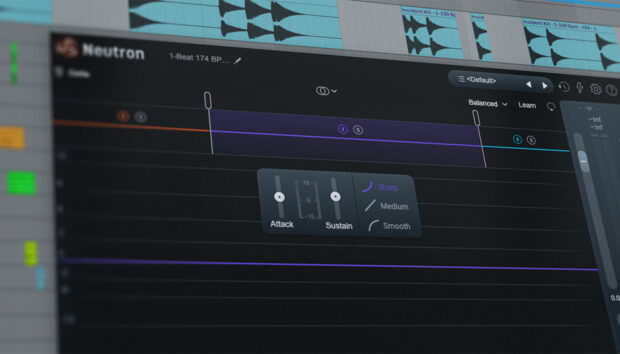
Enhance your drum beats with Neutron 5 Transient Shaper
Give your beats a tighter, more impactful sound with Neutron 5 Transient Shaper. Use multiband transient processing to help your…

12 of the best piano plugins and VSTs from Native Instruments
The best piano plugins for every genre. From classical grands to hybrid keys, learn about the best piano VSTs in…

9 music trends to look out for in 2025
Find the next big thing! Discover the music trends of 2025 in this article exploring the future of music, covering…

How to create wide bass lines
Looking to make your bass sound better? This guide will help you understand mid/side processing and make fuller, more prominent…
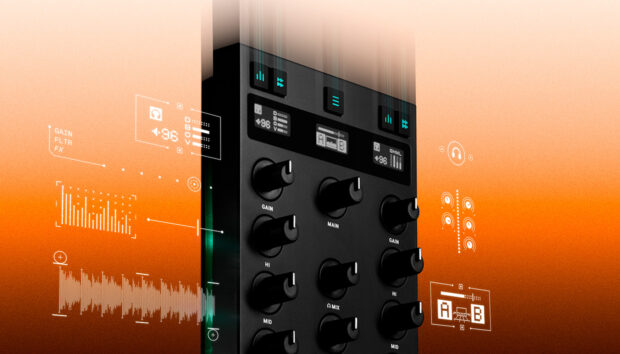
How to customize Traktor Z1 MK2 for DJing
Learn how to customize your Traktor Z1 MK2 with personalized features and color options. Discover step-by-step tips to enhance functionality…
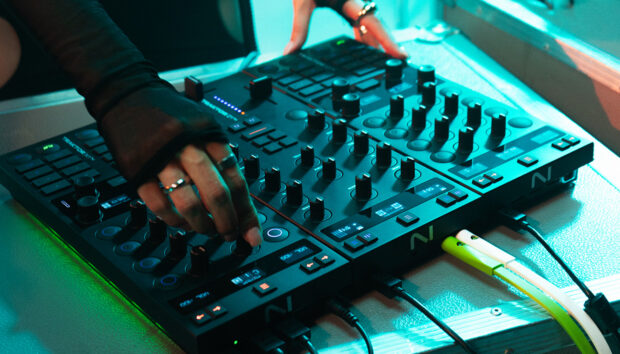
What is modular DJing?
Learn what modular DJing is and how to use Traktor modular DJ controllers to elevate your DJ setup. Discover the…

What is the 6/8 time signature?
Curious about the 6/8 time signature? This guide explains how to count 6/8 time, with examples and beat patterns to…
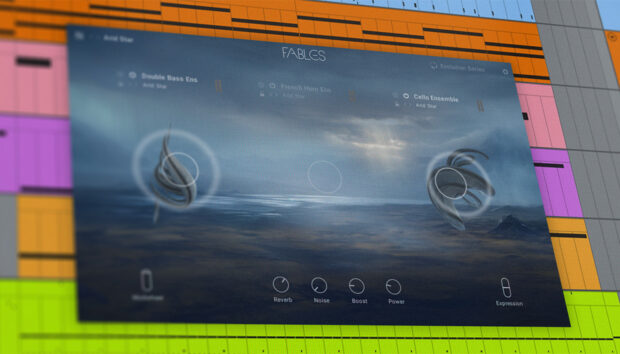
How to make a soulful score with Fables
Create complex, cinematic scores with Fables. This guide shows you how to customize presets and layer sounds to create a…
Pro Audio Files

RECOMMENDED
The what, why and how of modular synthesis.

Article Content
The world of Modular Synthesis is exploding with possibilities and continues to expand with new developers entering the market with innovative and unusual products on a regular basis. There has been much written about it in the last few years and major industry magazines like Sound on Sound now have monthly sections dedicated to Modular gear. So what exactly is it? Why is it so popular? And how do you get started?
Brief History — What is Modular Synthesis?
Modular Synthesis began as a bicoastal phenomenon with Don Buchla on the West coast and Robert Moog on the East coast in the 1960s. Both were developing products for musicians looking to explore new electronic sounds. Each had different approaches and there was not a lot of communication between them at the time. Buchla’s clientele were more on the experimental side of the spectrum and interested in machine music and generative type approaches. While Moog was interested in making playable devices for performers in the mainstream. Tony Rolando from Make Noise gives an excellent presentation on the beginnings of modular here .
Buchla made the choice to explore new types of user interfaces for his instruments:
“The electronic and functional sophistication of the individual modules, coupled with the ability to connect or “patch” them together in whatever way the user fancied, gave musicians and composers enormous power to create unique, never-before-heard sounds. In that spirit, it’s worth noting that Buchla tends to not refer to his instruments as synthesizers, since the name connotes imitating existing sounds and/or instruments. Rather, his intent is to make instruments for creating new sounds. Unrestrained artistic expression is the order of the day. Buchla’s design goal manifests itself in many ways, including the omission of a standard piano-style keyboard and the addition of a unique “multi-dimensional kinesthetic input port” controller.” ( source )

Moog, on the other hand, attached traditional keyboards, which made his instruments more accessible to musicians with an existing skill set. This may be one reason, if not the main reason, for the prevalence and financial success of Moog instruments in comparison to Buchla.
For a list of Moog synthesizer players, click here .

The main premise behind modular synthesis is that by connecting various modules together the user can construct unique signal paths capable of synthesizing sounds. In self-contained, non-modular gear, there are hardwired connections under the hood and the functionality is relatively fixed regarding the number of oscillators, LFOs, envelopes, etc., that are built into the device. With modular, there is the ability to expand the system in infinite ways, simply by adding more modules. Devices control or are controlled by other devices by means of CV (control voltage), the lifeblood of modular. Patch cables are used to send voltage throughout the system.
The problem with modular in the early years was the exorbitant cost, which made the devices inaccessible to the average musician. The advent of digital synthesizers in the late 70s and early 80s drove what seemed like the final nails in the coffin of the modular synth.
The introduction of the Doepfer A-100 analog modular synthesizer and the Eurorack format by Dieter Doepfer in 1995 changed all that. The standard was adopted by other manufacturers and since then the sector has exploded with hundreds of companies producing exceptional and innovative products.
Every Eurorack device is compatible in terms of rack dimensions (3U), power requirements and CV expectations, so you can freely connect modules with standard 3.5mm single conductor patch cables. Although there are other systems worth exploring such as Buchla, Frac and Serge, Eurorack has remained dominant, at least for the time being, with many more module choices available.

Why Modular?
With increased competition comes a lower price, and it’s now possible to assemble a system for a fraction of the cost that was prevalent 50 years ago. Still, the price is higher than buying a self-contained synth or having an array of soft synths. You can expect to spend anywhere from $500 for a small semi-modular device to $1500 for a minimally-equipped modular system and up to the sky from there.
So why bother? This is where subjectivity enters. Many will argue that modular simply sounds better, richer, warmer (or whatever adjective you prefer), and that analog has qualities that cannot be replicated in the digital world. Others shy away from the idea of the patch cable rat’s nest, the extra cost, and lack of presets.
Everyone has a unique background and their own experience, so I would not presume to make recommendations for any musician. I do suggest visiting your local modular shop to hear some sounds, move some knobs and check out the myriad of interfaces currently on the market. If you’re in the Los Angeles area, Perfect Circuit has an excellent showroom for just such an experience. You won’t find a substantial collection of modular gear at your local Guitar Center, so if you don’t have a synth shop or pro music store nearby, you’ll have to find other means.
Although experiencing tremendous relative growth, modular is still a niche market and will probably remain so. But there is a huge online presence of enthusiasts and active users such as muffwiggler.com , perhaps the most popular forum out there. The second-hand market is flourishing as well, with used modules fetching up to 75% of their original value. If you can solder, you might also explore some of the many DIY module kits, which will save you a bundle.
The choice to go modular should not be taken lightly. Those that take the plunge may quickly discover that it’s an infectious and addictive path that demands ongoing investment. My personal gateway drug was the Moog Mother 32 semi-modular synth. A semi-modular device is a self-contained unit that requires no other modules to function. It has hardwired connections and a patch bay of 3.5mm jacks that allow alternative signal paths either within itself and/or with other devices as well.

I was so enchanted by the sound of the Mother 32 that my system soon exploded to include the two racks below in a matter of months.

The images above, by the way, are generated by the website: ModularGrid.com . This site allows you to virtually construct systems based on the size of your case and the power/current requirements of your devices. My system is modest at best, when compared to some that have literally walls of modules. “They tried to make me go to rehab but I said, ‘No, no, no…'” (Amy Winehouse)

Ready to elevate your ears?
It doesn’t have to take years to train your ears.
Get started today — and you’ll be amazed at how quickly using Quiztones for just a few minutes a day will improve your mixes, recordings, and productions!
How to get started?
Unless you start with a semi-modular synth like the Mother 32 mentioned above, you’ll need some basics to get up and running.
Here are the main components of a system:
- Case and Power Supply — Euroracks are typically in rows of 3U or 3 rack spaces each and measured horizontally in terms of HP (horizontal pitch). Typical widths are 84 and 104 HP. Check out modulargrid.com mentioned above. Obviously, more room in a rack will lead to more investment, because no one likes an empty space in their rack. Some racks come with built-in power and some will need a power supply purchased separately. The investment in a rack is typically one of the largest cash outlays and should not be taken lightly. Try to project your future needs and portability requirements before making a choice.
- Oscillators or Full Synth Voices
- VCFs — Voltage Controlled Filters
- Envelope Generators
- LFOs — Low Frequency Oscillators
- VCAs — Voltage Controlled Amplifiers
- Multiples for duplicating a signal
- Waveform Processor
- Slew Limiter
- Effect Processor (Delay/Reverb, etc.)
- Clock divider
- Attenuverters
- Random Voltage Generators
- Interface modules for getting MIDI and/or Audio in/out

Interfacing with the Digital World

Proceed with caution. If you have a firm grasp of synthesis fundamentals, significant experience with either physical or software instruments, at least two months of rent in the bank or an empty credit card, and a desire that cannot be quashed by the most insistent significant other, go for it! But be forewarned, modular synthesis is not for the faint-hearted or the inexperienced synthesist.
I strongly recommend cutting your teeth with virtual synths first and learning the basics of sound, signal path, modulation, and synthesis in general.
Check out my other articles, reviews and interviews
Follow me on Twitter / Instagram / YouTube
Philip Mantione
Eleveate your ears.

Videos You Might Like

iZotope VocalSynth: Basic Processing Effects (Part 3)

Using Visual Art to Inspire Improvised Ambient Atmospheres

Tutorial: Using VocalSynth 2 in a Pop Song
Advertisement

Modular Synthesis: The Complete Beginner's Guide

Modular synthesizers are in a resurgence period, and I'm not complaining. For a long time, they've captivated musicians with their unique analog sound and unparalleled tonal control.
However, even if their allure has piqued your curiosity, you might be left wondering how to effectively harness their power.
In this article, we will delve deeper into the practical applications of modular synthesis and take a closer look at the many components and techniques involved in the process.
Hopefully, by the end, you'll have a better understanding of how to navigate the world of modular synthesis and unlock its creative potential.
What Is a Modular Synthesizer?
In essence, a modular synthesizer is an electronic instrument that is made up of various modules, each serving a specific function, to generate sound.
Each of these unique modules is interconnected using sliders, switches, patch cables, and panels, giving players a wide range of connection possibilities.
The important thing to understand here is that there are typically two main types of signals:
- Audio - The signal that represents the final output sound
- CV (Control Voltage) - The signal that controls various parameters of the modules.
And if you're sitting here thinking,
"This is already sounding complicated..."
Don't worry.
Before we get super deep into the weeds, we'll familiarize ourselves with the necessary terminology.
First, however, let's explore where modular synthesis came from.

A History and Evolution of Modular Synthesizers
The origins of modular synthesis can be traced back to the late 1950s, when German engineer Harald Bode developed the first hardware unit.
A decade later, the iconic Buchla Modular Electronic Music System and Moog synthesizer were introduced. You've likely heard of Moog before.
This one-of-a-kind synthesizer consisted of separate modules that generated and shaped sounds, including filters, noise generators, envelopes, sequencers, and more, all of which were interconnected using patch cords.

When the 1970s rolled around, the Japanese company Roland sent shockwaves into the modular community with the release of the Roland System 100 in 1975. They would continue following this synth up with the System 700 in 1976 and the System 100m in 1979.
Roland had effectively expanded the possibilities of modular synthesis and brought new sonic capabilities to the burgeoning frontier.
However, the dominance of modular synthesizers in popular music began to wane as the 1970s went on, as samplers, MIDI-connected gear racks, and highly integrated keyboard synthesizers rose to prominence.
By the 1990s, modular synth sales dropped even further, as more affordable and compact digital and software synthesizers emerged.
However, even with a clear cultural shift, there was still a dedicated community of musicians and enthusiasts who preferred the physically patched approach. It was the flexibility and unique sound characteristics offered by these traditional modular systems that they couldn't get enough of.
When the 2000s rolled around, there was a notable resurgence in the popularity of analog synthesizers.
With a wider availability of retro gear, lower production costs, and improved electronic stability and reliability, there was a renewed exploration of modular modules.
Now, with the development of virtual synthesis systems such as Reaktor, Pd, MAX/MSP, and VCV Rack, the resurgence is larger than ever before.
Understanding the Basics of Modular Synthesis
At the heart of modular synthesis is interconnectivity .
Unlike conventional synthesizers, modular instruments consist of multiple interchangeable components called (drum roll) modules.
Interestingly, modular synthesizers are easier to get a grip on than their non-modular counterparts, particularly when you start unraveling the fundamentals of synthesis.
With a modular synthesizer, you can visually and physically separate each component into distinct modules, giving you a better idea of how they function.
Now, while there are some modules available that offer a wide range of capabilities, most modules are designed to fulfill a specific role within the greater system.
I like to think of modules in a modular synthesizer as human organs. They each serve a different function for the body and are interconnected through a network of patch cables like our veins.
Let's explore the unique roles played by each component to get a better understanding.
Control Voltage (CV)
Control voltage serves as the communication medium between your system's modules.
As a result, many modular synth components are often described as "voltage controlled," such as a voltage controlled amplifier (VCA) or voltage controlled filter (VCF).
You can find CV inputs in modulation-ready modules. For instance, a filter module will typically feature a CV input you can use to control the cutoff frequency.
Oscillators
Without an oscillator, your synth simply cannot live and breathe.
The oscillator is the central component that imparts a distinct sound and timbre to any given synthesizer. Oscillators come in all shapes and sizes, though there are a few essential aspects to understand about them.
When it comes to modular synthesis, an oscillator's pitch is governed by the volts per octave (V/oct) standard. The oscillator will receive precise instructions through control voltage regarding the frequency at which it should oscillate to produce a specific musical note.
Without this V/oct control voltage, we wouldn't have accurate pitch control within the modular synthesizer system.
One unique thing about this level of pitch control is that modular oscillators allow for seamless transitions between western semitones and more atonal or half-tone sounds.
Lastly, it's important to note that modular oscillators typically generate sound in a continuous manner, meaning you need an amplifier and an envelope to govern the activation and deactivation of played notes.
While certain oscillators may incorporate built-in envelopes, gating the sound, this activation and deactivation is generally achieved using a separate module.
If you've ever produced or performed basic mixing or editing tasks, you may already have some familiarity with filters.
In the modular synth world, they're crucial.
Filters play a vital role in shaping the sound by selectively boosting or removing specific frequencies, just like you would with an EQ in your DAW.
The most common filter types include high-pass filters and low-pass filters .
High-pass filters allow higher frequencies to pass through while attenuating low frequencies, while low-pass filters permit lower frequencies to pass, while attenuating high frequencies.
That's not all!
Filters can also incorporate resonance, which is a feedback control that accentuates the center or cutoff frequency of the filter. Resonance is a wonderful tool for emphasizing specific frequency ranges.
Of course, if you already have a decent knowledge of basic synthesis, you likely understand the significance of filters when it comes to sound design.
Without them, you're limited to the range of sounds your synth can produce.
Amplifiers (VCAs)
Amplifiers are one of the simplest components in the modular setup, regulating the volume of the oscillator with control voltage and/or a volume knob.
In a modular synthesizer, however, amps have a primary function of acting as gates for the oscillators and other sound generators, giving players precise control over when the sound is heard or muted.
Amplifier modules are often compact and feature two or more VCAs.
For instance, the WMD Triple Bipolar VCA module offers three VCAs with bipolar control, allowing for both positive and negative amplification. Each VCA features dedicated control voltage inputs and 'attenuverters' for precise control over the audio signals. It also includes an option for cascading the VCAs, allowing you to cook up even more complex modulation possibilities.
Envelopes Generator (EG)
There are two significant roles that the envelope generator plays in a modular synthesizer setup.
For starters, it governs the volume of the amplifier with four essential parameters: attack, decay, sustain, and release. You've likely heard of ADSR before.
Each of these parameters determines the time it takes for the oscillator's signal to reach its peak volume, transition to a secondary volume level, and eventually decay to zero once the note is released.
Collectively, they shape the dynamic contour of any given sound.
ADSR is widely recognized as the standard modular synth envelope generator, though for those seeking more intricate modulation possibilities, there are also several other complex options available.
For example, you can use an envelope generator to modulate the filter's cutoff frequency.
The beauty of modular synthesizers lies in the rearrangement flexibility of the components, so an envelope generator could easily be repurposed to control an oscillator's pitch.
Modulation Sources
Beyond envelope generators, modular synthesizers offer a wide range of modulation sources for adding movement, variation, and dynamics to your sounds.
Modular synthesizers offer a wide range of modulation sources that add movement, variation, and dynamics to the sound. Three commonly used modulation sources in modular synthesizers are LFOs (Low-Frequency Oscillators), envelopes, and sequencers.
LFOs, or Low-Frequency Oscillators, are oscillators that operate at a much slower rate than audio-range oscillators., generating numerous types of waveforms, including sine, triangle, square, and sawtooth.
We primarily use LFOs for cyclic parameter modulation. With an LFO, we can affect the sound's pitch, filter cutoff, amplitude, and more.
Beyond that, they also provide an opportunity for adding rhythmic effects, such as vibrato and tremolo.
While LFOs are certainly a crucial modular synthesizer element, they're nowhere near as exciting as sequencers .
A sequencer is used to generate repeating and evolving control voltage or MIDI patterns. In modular synthesis, they provide precise control over the timing and sequencing of musical events, allowing players to create melodies, rhythmic patterns, and more.
Patch cables and Patching
Lastly, we need to have a basic understanding of patch cables and their routing, as these are fundamental aspects of modular synthesis that create the interconnection we've been discussing.
So, what in the heck are patch cables?
Patch cables are indeed actual cables with connectors (usually 3.5mm jacks) used to establish connections between modules.
They provide control voltage and audio signal transmission between the various components of a modular synthesizer. You can buy them in a wide array of lengths and colors too, which makes it easier to identify and organize the signal paths in your system however they make the most sense to you.
Building a Modular Synthesizer Setup

If you want to build your own modular synth, the format is the first and most important decision you'll have to make. Different formats offer unique characteristics, module availability, compatibility, and aesthetics.
Some of the most popular include Eurorack, Buchla, Serge, and Moog.
For the purpose of this article, we'll talk about Eurorack modules, as they're arguably the most popular.

Your modular synth system setup will begin with its enclosure or case. This is going to be the thing that houses the modules and provides power to them.
I highly recommend checking out the Doepfer A-100 LC1 if you're looking for a budget-friendly case, as it features an integrated bus board with eight module slots, allowing for the installation of multiple modules.
Plus, it comes with a power supply.
Basic Building Blocks
One of the most basic components of a modular system, whether it's for live performance or studio work, is the output. This piece establishes a connection between your system and your ears through an audio system.
At some point down the line, you might want to integrate external signals into your Eurorack setup. This is where input and output modules come into play.
I recommend checking out the Make Noise XOH Output Module for a good starter.

You'll find a relatively wide range of options available for sound production when it comes to Eurorack systems.
Subtractive sound synthesis is one of the most common synthesis types you'll find in these systems, which is great, as the subtractive voice process is the best one to start with when designing an initial modular system.
With subtractive synthesis, you'll often find oscillators that are routed through a voltage-controlled amplifier (VCA) into a voltage-controlled filter (VCF). LFOs and Envelopes are then used to modulate the overall sound.

One of my favorite units is the 4ms Ensemble Oscillator , which combines 16 complex oscillators and uses a combination of wavefolding, additive, FM, and phase-distortion synthesis for users to create unique soundscapes.
One of the last basic building blocks you need for sculpting your initial sound is a filter module. The market offers a wide variety of modules from various manufacturers, each with its own unique concept.

It's super important to closely examine and understand the functionality of these modules if you want to get the desired sound. Multimode filters, for example, like the extraordinary Waldorf VCF1 , have a particularly intriguing sound, all thanks to its numerous inputs and outputs, and its triple distortion-stage design (two stages of which have independent outputs).
Utility Modules
When working with multiple sound sources in a Eurorack system, incorporating a mixer is crucial. You'll want one with modulation inputs that can blend audio signals and control voltages.

Now, depending on the manufacturer, you might find additional functionality. One of my favorite modules is the ACL Gate Mix module, which offers a four-channel mixer with a voltage-controlled mute function.
It's incredibly sturdy in terms of construction and provides low-noise operation for the most natural, non-colored sound output possible.
You may also want to get yourself an attenuator to reduce the level of your signal passing through your system.
Attenuators are primarily used to adjust the amplitude or strength of a control voltage (CV) or audio signal, often providing a knob for dialing in the desired attenuation amount. These modules are useful for controlling modulation depth, adjusting signal levels to match other modules, and fine-tuning various system parameters.

I'm a big fan of the QUA Quad Attenuator from Rides In the Storm, which features individual signal paths for pre-defined or performative attenuation. For an inexpensive module, it offers a surprising amount of modulation control.
Modulation Modules
Modulation is what brings excitement into modular system. Without it, the various components of your system can't interact as they should, and you can't create the same level of dynamic and distinctive sounds.
Low-Frequency Oscillators (LFOs) and Modulators play a crucial role here.

One of the best modulator modules on the market today is the Erica Synths Modulator module. This versatile module provides a 2-channel LFO, eight selectable waveforms, and a noise source. You can easily blend the eight waveforms together, giving you a wide range of shaping options, depending on your preferences.
Next, you'll want a module to shape the envelopes in your synth. This is where envelope generators come in.
With the right one, you can unlock highly distinctive sounds in your modular system.

One of my favorites is the Mutable Instruments Stages Segment Generator, which functions as a six-stage envelope or an ASR (Attack-Sustain-Release). You can also use it as a four-step sequencer and an LFO (Low-Frequency Oscillator) for even greater modulation versatility. The evolving sonic possibilities with this retro little unit are near endless.
Of course, no modular synth is complete with a sequencer.
A good sequencer opens you up to more diverse melodic and rhythmic structures. Luckily, you'll find a wide range of sequencer options available, leaving no shortage of potential experimentation.
The Doepfer A-155 is somewhat of a class, delivering reliability and functionality with two rows of switches, each of which has eight steps. And if that feels limiting, note that it can be expanded further with the Doepfer Sequencer Controller A-154.
Effects Modules
Modular system effects are the spices and sauces in your modular synth recipe, offering unique character and flavor.
As with digital effects of stompbox effects, each effects module brings its own distinct texture, offering fresh creative possibilities.

For example, the Radikal Technologies RT1701 EFFEXX module offers a dual multi-effect, eight-algorithm design with a gorgeous-sounding reverb processor. The animated stereo effects that you can get from this unit are nothing short of captivating.

On the other hand, you have the Softube Clouds by Mutable Instruments , which offers a broad range of virtual effects, such as a granular effect that splits the input signal in real-time into up to 16 grains, allowing you to manipulate the size, texture, density, pitch, and position of each.
From physical effects modules to virtual effects modules, you have an extensive selection to pick from, so I recommend first considering the genre you often work in and the specific effect or effects that best complement your artistic vision.
Final Thoughts
Stepping into the world of modular synthesis can feel overwhelming, especially for beginners. Even experienced users may find it daunting at times.
However, I find that, comparatively, modular synths offer a fun and fulfilling experience, giving you the chance to create distinct sounds while providing a better understanding of the fundamentals.
With the right kind of research, you can embark on the right path to start building a truly remarkable modular synth that will provide you with countless years of enjoyment and boundless creative possibilities.
Take your time when exploring and learning about modular synths. As with anything in music, if you take time to embrace the discovery process, you'll get a better grasp on the vast potential that modular synthesis has to offer.

Bring your songs to life with professional quality mastering, in seconds!

Audio production tips and tricks from eMastered’s Grammy winning founders, straight to your inbox every week.

Modular synthesis: the ultimate beginner's guide
A look into the wonderfully complex world of modular
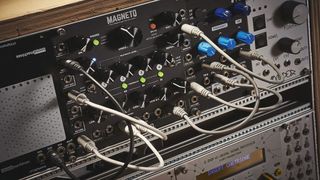
So, what exactly is a modular synth ? Well - it’s a synthesizer whose components come as individual modules, allowing the user to define the functions and layouts of the system and then define the signal paths for both audio and modulation, through a process known as patching.
The first available modular systems were designed in parallel by the R.A. Moog Co (on the east coast of the US) and by Buchla (on the west coast of the US) in 1963. The question of who made “the first” modular synth is a hotly debated topic, with both Bob Moog and Don Buchla often citing the other as the first to get there.
Move forward 32 years and we see Eurorack brought to life by Doepfer in 1995 with the release of ten modules and a system that defined the Eurorack standards. Eurorack modules are 3U high (U is rack units also used to measure rack-based synths and studio processors) and module widths are measured in HP (standing for horizontal pitch).
So why choose a Eurorack set-up? That’s a simple one… they offer ease of entry and a vast range of options to build your own instrument/device to suit your exact needs. The format has been expanded not only by Doepfer but by a huge range of companies releasing modules ranging from the cheap and cheerful to esoteric and unique.
Eurorack offers a platform that can pull ideas from not just Moog and Buchla but also Serge and EMS, a range of digital synthesis methods, modern DSP technologies and more.
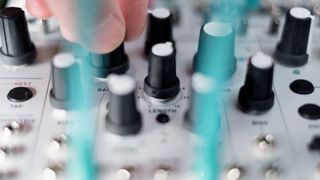
When to use it
With such an array of modules available today, it’s hard to pinpoint a specific musical application best suited to modular synthesis - modules can be rearranged and combined to create a set-up that works in almost any context.
Modular synths are ideal for those who want to exercise some more control over their creative process, giving you the opportunity to build an instrument that’s truly your own.
Get the MusicRadar Newsletter
Want all the hottest music and gear news, reviews, deals, features and more, direct to your inbox? Sign up here.
Eurorack must-haves
Unlike other gear, Eurorack modules are far from ‘plug and play’ without some architecture around them. There are three things you need to get started: a way to mount your modules, power and a way to control your modules.
Modules mount on rails that can be screwed into end cheeks on a desktop, connected to brackets or rack ears and mounted inside a case.
You screw your modules onto the rails and then plug in their power cables (16 or 10-pin ribbons on the module side) into the buss boards that distribute power (these are headers with 16 connection pins) through the system.
Power either comes into the case as mains voltages and is controlled with an internal supply or can be an external supply that regulates voltages for the buss boards in the case.
Power can even be a module itself. You also need a way to control your system, be it manually, with controllers, sequencers or keyboards. There’s lots to explore.
Which modules to choose?
Once you have a case, power and a way to control your modules, you’re no doubt going to be in a world of excitement dying to create your own sonic adventure. There are lots of options for different styles and sounds even within the same type of synthesis. Say you want to build a Moog replica, there’s more than one set of modules that will get you close.
The same applies for a Serge voice replica or Buchla-style system – it’s pretty endless. We recommend avoiding a very specific pre-planned route and to think in more simple terms. You’ll need a sound source, a processor and a modifier. That could be an oscillator, filter and envelope. Or it could be a sampler , FX and LFOs .
Thinking in more simple terms will help you explore options and build a system that is unique to you. Mix up your Moog-style oscillators, Serge wavefolders and modern DSP. That’s the beauty of the platform.
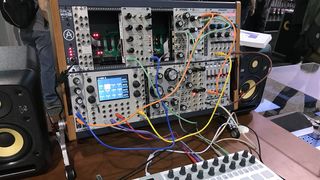
Once you've got started...
Make your own patches.
Every patch you make on a modular system is your own. There’s no presets and pre-routing that define the sounds you use or the modulation. Patching is done with 3.5mm mono cables and any output can be plugged into any input. Patch up something familiar to get started.
Look at your favourite soft synth/hardware synth and follow the signal path. Chances are you’ll have oscillators going into a mixer, into a filter and into a VCA, and LFOs and envelopes used to control sound. Try to remake its signal path for both audio and modulation on your modular. Then try re-routing signals to create something more unique.
Create an FX processing set-up
You’ll need audio inputs to bring in external sounds so pick out an input module then choose some FX. Modulation is often key to creating something engaging and unique. So while filling a case with FX modules might be fun, it will be even better with some modulation.
Be sure you have envelope followers to get input dependent CV data you can patch around your system. Imagine if the harder you play, the longer the reverb trail, or more resonant your phase shifter is… nice! LFOs/sequencers will help animate even the more stale FX (think of this as your automation generation) so be sure to leave room for some.
Emulate the West Coast
Start with a dual complex oscillator – a module with two oscillators that can modulate each other to create a range of FM and AM sounds alongside oscillator sync and sometimes even additional waveshaping too. This is where you can generate a huge range of unique and complex tones not heard in many other synths.
You’ll want a low-pass gate (LPG) to control the high-end frequencies and amplitude in your signal. Patch in your gates and triggers to the LPG to open the sound and let the vactrol ring in with its natural sounding decay. A good place to start is with Make Noise , Sputnik Modular and Verbos Electronics.
Create a Moog-style monster
However experimental we’re trying to be it’s hard not to love the sound of a deep saw wave through a meaty low-pass filter that’s saturating and chewing your frequencies like it’s not had a meal in days. For us the Moog sound is all about the filter; not entirely but get the right filter and you can get very close to sounding like a Moog system regardless of the oscillator(s) at the input.
The filter was a low-pass ladder design and we suggest checking out the AJH Synth MiniMod range for incredible clones of a Moog Model D . To re-create the Model D you’ll need three oscillators, a mixer, a filter, two envelopes and a VCA.

Future Music is the number one magazine for today's producers. Packed with technique and technology we'll help you make great new music. All-access artist interviews, in-depth gear reviews, essential production tutorials and much more. Every marvellous monthly edition features reliable reviews of the latest and greatest hardware and software technology and techniques, unparalleled advice, in-depth interviews, sensational free samples and so much more to improve the experience and outcome of your music-making.
"We anticipate that the first 1000 will sell out very quickly": Here's how to get your hands on Orchid, Tame Impala's ultra-hyped chord-generating synthesizer
Behringer says it's squeezed the sound of a Roland Jupiter-8 into a $99 portable package with the JT Mini analogue synth
“All the music software you need… but for the price of a mid-level Apple Mac”: Native Instruments Komplete 15 review
Most Popular

Meet Vector, an experimental exploratory hardware synthesizer combining elements of several synthesis methods into a very special expressive blend. With a touchscreen interface, smooth rotary encoders and firm toggles for navigating the partials — how they evolve, modulate, mix and cut.
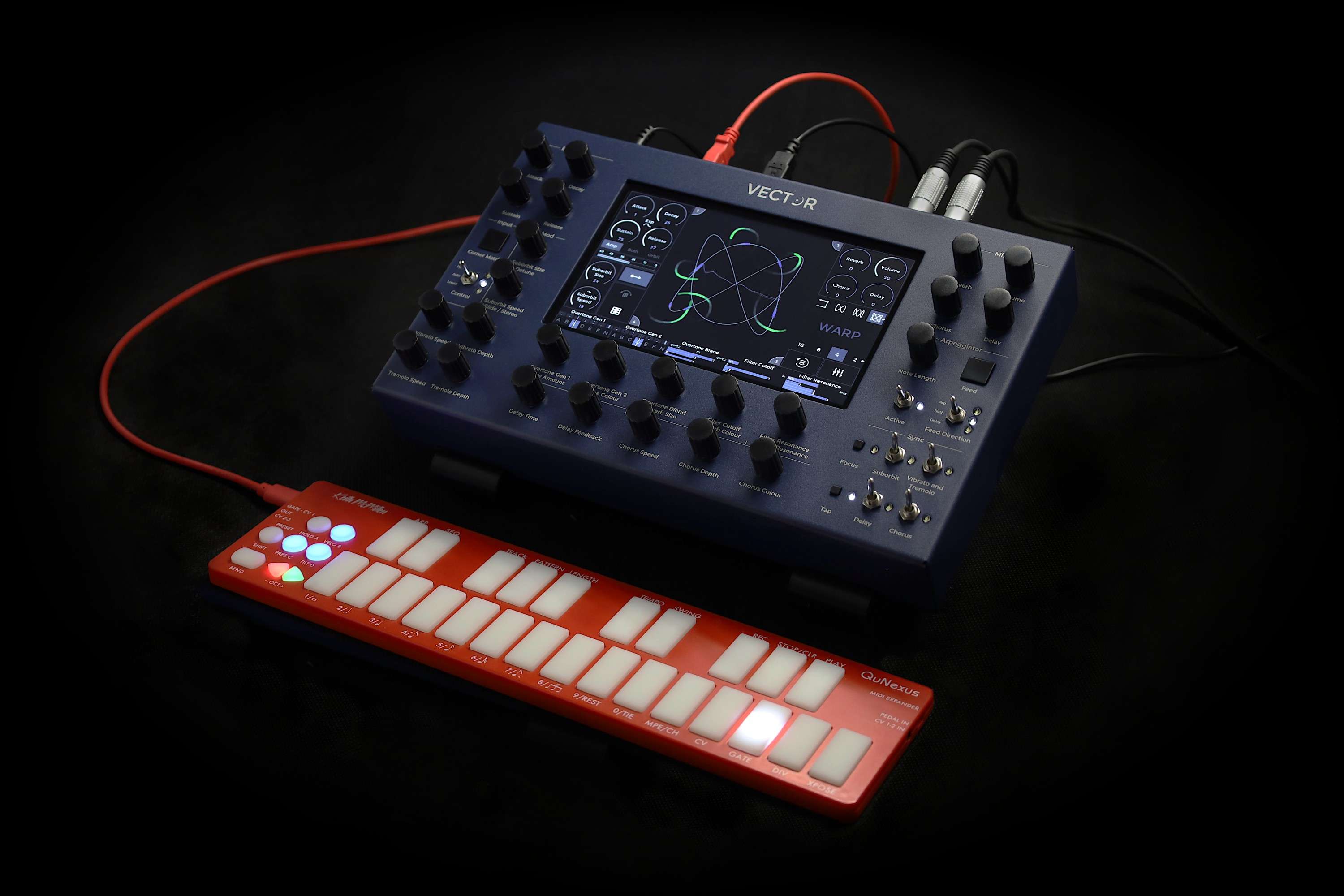
Explore unheard of tonal landscapes with a novel synthesis approach with a total of 64 filters, 128 harmonic generators and 64 blenders at your disposal.
Manipulate partials and motion in realtime with procedural orbits and trajectories.
Leave the comfort zone to create unique sounds, unlike anything else, with a complete synthesis workflow.
Easily upgrade the firmware directly over a local network or with a USB stick.
While Vector is great already, we are making it even better by adding new features .
Get active and engaging support from the makers, because Vector is made for you.
- Innovative hybrid synthesis engine
- Complex modulators
- 16 voice polyphony with 4 filters per voice
- Extensive arpeggiator with a step sequencer
- 4 carefully tuned rich effects
- 7" capacitive touchscreen
- 25 smooth infinite rotary encoders
- 7 toggle switches
- Metal body 29×18×5cm (total height 7.5cm)
- 1.5kg weight, built like a tank
- Stereo 6.35mm output (2× mono jack)
- Stereo 6.35mm headphone output
- Ethernet port
- USB device, USB host
- MIDI TRS input and output ports
- Runs on ARM® Cortex™-A53
- Powered by realtime Linux
- 32-bit internal processing
- 32-bit DAC (106dB SNR)
- Firmware upgrade via LAN or USB drive
Red Means Recording

Benn Jordan

Bloom Music

Les Sondiers

The Midlife Synthesist

June and Arrival

Starsky Carr

Powerful arpeggiator and an array of effects to sculpt the sound to taste.
Responsive and snappy UI with a careful balance between hardware and touch.
Mono, Poly and Dual modes for a thick unison or interval playing.
Stand-alone, Send and Receive MIDI tempo modes to sync Vector with your devices.

You can easily create an evolving ambient patch that sounds both delicate and huge at once.

Tinkerers and individualists should get their money's worth, as well as live people who like to get lost in improvisation.
Experience Vector
Ready to ship Tracked worldwide delivery
EU taxes and VAT do not apply (shipping to United States) Change country

Subscribe to our mailing list
Hang around with us.


IMAGES
COMMENTS
Jun 27, 2024 · Modular synthesis is all about experimentation, and refining your sound is an essential part of the process. Here are some tips for experimenting and refining your sound: Experiment with different module combinations and connections. Modular synthesis is a highly flexible technique, and there are countless ways to combine modules to create new ...
Jun 4, 2024 · Whether you’re a seasoned producer or an experimental artist, modular synthesis offers a limitless platform for creative expression. Audio Processing. Modular synthesis has found a new home in the world of audio processing. The flexibility and versatility of modular synthesis make it an ideal tool for a wide range of audio processing tasks.
Dec 30, 2023 · One of the main benefits of using a modular synth is the ability to create unique and experimental sounds that are not possible with a traditional synthesizer. Modular synths also allow for a deeper understanding of the underlying principles of synthesis, as the user has complete control over every aspect of the sound.
Oct 9, 2024 · Modular synthesis is used for the same music-making tasks as conventional synths, whether it’s adding a dreamy lead line to a track, dialing in a bassline, or conjuring funky blips and squelches. But there are some tasks that modular synths particularly excel at.
Aug 20, 2017 · The choice to go modular should not be taken lightly. Those that take the plunge may quickly discover that it’s an infectious and addictive path that demands ongoing investment. My personal gateway drug was the Moog Mother 32 semi-modular synth. A semi-modular device is a self-contained unit that requires no other modules to function.
Feb 3, 2021 · Jameson Nathan Jones is a classically trained pianist turned ambient synthesist exploring the rich textures of analog synths, digital sound design, and modular granular effects in his solo music as…
Jun 16, 2023 · In modular synthesis, they provide precise control over the timing and sequencing of musical events, allowing players to create melodies, rhythmic patterns, and more. Patch cables and Patching Lastly, we need to have a basic understanding of patch cables and their routing, as these are fundamental aspects of modular synthesis that create the ...
Jan 2, 2024 · The first available modular systems were designed in parallel by the R.A. Moog Co (on the east coast of the US) and by Buchla (on the west coast of the US) in 1963. The question of who made “the first” modular synth is a hotly debated topic, with both Bob Moog and Don Buchla often citing the other as the first to get there.
Meet Vector, an experimental exploratory hardware synthesizer combining elements of several synthesis methods into a very special expressive blend. With a touchscreen interface, smooth rotary encoders and firm toggles for navigating the partials — how they evolve, modulate, mix and cut.
Sep 7, 2016 · Kaitlyn Aurelia Smith came to modular through a fortuitous route. Holed up in a friend’s garage to work on a post-graduate music project, she was handed a Buchla synthesizer as part of her explorations. Famously frustrating for beginners, the synth just wouldn’t make noise for weeks on end, until finally she started to understand its quirks.